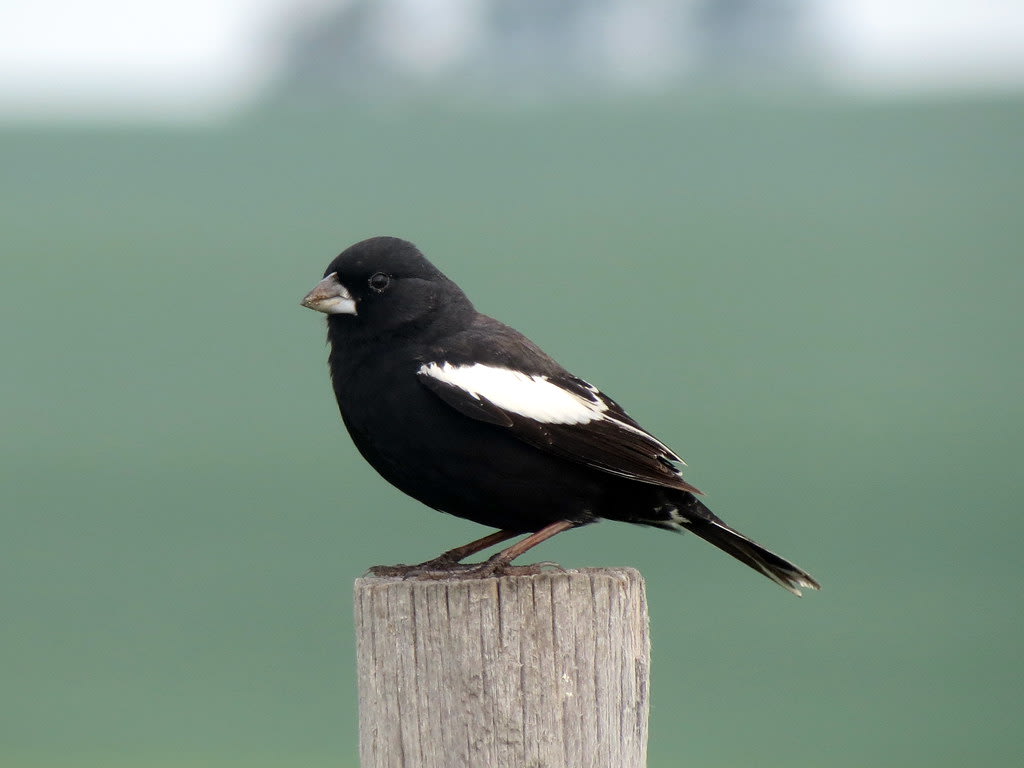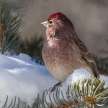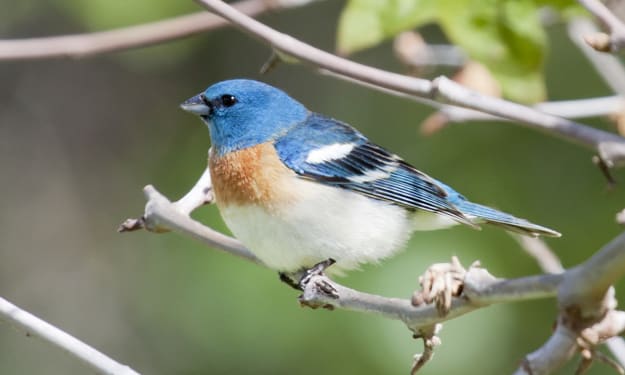
The Calamospiza melanocorys (lark bunting) is an American sparrow of small size native to Central and Western North America. This is the Colorado State album too. Lark buntings are small, bluish songbirds with a short, thick bill. There is a large patch of white on the head, and they have a relatively short tail with white tips at the end of the feathers. Breeding males have an all black body with a small white spot at the upper part of the head. Males and females who are not breeding look similar, and have white lines that are greyish brown. The lark bunting is the most common passerine species found in grasslands of North America. In Central Canada and the Mid- of the United States, their breeding area is prairie areas. These birds migrate in flocks in the fall to southern Texas winter, Arizona and the Northern Mexico high plateau. Usually the birds nest in scattered colonies. Males fly over their territories and sing to claim possession of a nesting area as they descend. The album contains a combination of whistles and trills. The call is a happy hoo. The nest is an open cup in a grassy field, on the bottom. While the lark buntings are sexually monogamous, significant extra-pair bonding is detected by extra-pair paternity. It is suggested by songbirds that there should be sexual monogamy due to inadequate possibilities for polygyny. As expected, the male - female violence, competing over mates, is important. Most males can not find a social partner that can be related to the sex ratio of male-biased marriage, sexual monogamy and the degree of extra-pair paternity. Acquisition of a social partner is an vital part of a male's fitness, and progress in social matching plays an significant role in variable selection of male traits. Specially significant is the sexual variability in lark buntings, as the choice of female partner varies significantly from year to year. Females have been expressing choice in different years based on males ' black colouring, wing patch colour, beak colour, as well as other characteristics. The effect of this dramatic variation of the female inclination from year to year is that several different male sexual ornaments hold genetic variations. A examination measures the colour of the body, the ratio of black to brown feathers on the rump and rest of the body, wing patch scale, wing patch shape, body size, beak size and residual mass to assess the potentially identified characteristics of females. Progress in social matching as well as total annual fitness were measured, and female preference was the primary criterion. Plasticity of female preference is preferred for adapting to changes in ecological and social settings. Temporal mobility in female preference is close to the trend seen in Darwin's finches, with different beak sizes and shapes chosen to change food supply over the years, defined in the sense of natural choice as temporary competition. In lark buntings, a feature that is chosen favourably after one year was theoretically negatively chosen against in a previous year. These dramatic differences underline the value of looking at sexual orientation patterns over a long period of time before any conclusions can be made. Yet it is possible to identify female inclination annually by looking at short time intervals, but for these statistics it is difficult to make any extrapolations. The potential loss in phenotypic selection for expression of the male phenotype is an incidental consequence of the annual female preference variation. Males are categorised as weakly territorial before mating, but there has been some work into territorial characteristics that suit female settlement, thus female reproductive success. Studies have shown that shade is an important instrument for successful female reproduction. As a mechanism limiting fitness, it would be safe to conclude that this may compensate males for any existing territorial behaviours. Nonetheless, the levels of male aggression do not change, contributing to the conclusion that female preference coincides with changes in fitness-indicator properties. Extra-pair matching has been associated with the accuracy of the spawning site, allowing the male aggression more characterisation. Several studies have shown territorial characteristics as important to mate selection, but a recent analysis reveals evidence of its declining role relative to female choice. Lark buntings forage mainly on the grass, eating mainly summer insects, and winter seeds; they also take brief flights to capture insects. They feed outside of the breeding season in flocks too. Until 1931 the lark bunting became the official bird of Colorado. A decrease in population has arisen with the destruction of the existing prairie ecosystem.
About the Creator
MB
I am a bird aficionado and really enjoy spotting them them on hikes. I greatly appreciate the variety of birds cross North America and the world. They are amazing and intelligent creatures, each so unique and with a wonderful life.
Enjoyed the story? Support the Creator.
Subscribe for free to receive all their stories in your feed. You could also pledge your support or give them a one-off tip, letting them know you appreciate their work.






Comments
There are no comments for this story
Be the first to respond and start the conversation.